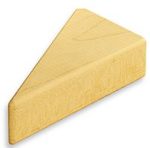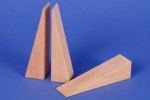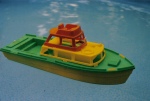On the second week of our Simple Machines unit, we studied wedges and levers.
Key concept of wedges: A wedge is two inclined planes, brought together in a sharp edge. You place that sharp edge on an object you want to cut or separate, then you add force to the flat side (input force, shown with the hammer above). The wedge pushes into the object, with the force pushing outward to separate it (output force).
Our activities included: cutting play-dough, hammering nails or golf tees, using scissors, exploring wedges in the sensory bins, and using wedges at snack time.
Big Idea
A demonstration: Give a child a pile of play-dough. Say “I want to cut this in half.” Have them try using the flat palm of their hand. They’ll figure out it doesn’t work – it just squishes the play-dough, it doesn’t separate it. They may figure out they can use the side of their hand. (Or you can suggest it.) That works better. Then give them a triangular
 wooden block with a sharp point – hold it like the wedge in the diagram above and show them how to push it into the play-dough. That cuts it much better. (Optional: you could then have them use a plastic knife – have them try to cut with the flat side of the knife, and then with the sharp side of the knife. Point out how thin the edge is compared to the side of your hand.)
wooden block with a sharp point – hold it like the wedge in the diagram above and show them how to push it into the play-dough. That cuts it much better. (Optional: you could then have them use a plastic knife – have them try to cut with the flat side of the knife, and then with the sharp side of the knife. Point out how thin the edge is compared to the side of your hand.)
 Explaining the key concept: Take one triangular block. Show how the hypotenuse forms an inclined plane. Then put two blocks together, showing how two inclined planes form a wedge. Turn that upside down – see how the sharp point is like the sharp edge we used to cut the play-dough? We can use that point to separate things. Balance two books so their spines face up (or put two rectangle blocks on their sides next to each other). Push the wedge between them and it pushes them apart.
Explaining the key concept: Take one triangular block. Show how the hypotenuse forms an inclined plane. Then put two blocks together, showing how two inclined planes form a wedge. Turn that upside down – see how the sharp point is like the sharp edge we used to cut the play-dough? We can use that point to separate things. Balance two books so their spines face up (or put two rectangle blocks on their sides next to each other). Push the wedge between them and it pushes them apart.
Book and Song: Choose from those listed in the Simple Machines post. We read, and sang: Move It! Work It!: A Song About Simple Machines.
Optional additional concept: Doorstops, shims and wheel chocks are all wedges. They’re like ramps you shove underneath an object (or between two objects) to make it harder to move. It’s a little tricky to explain to kids how this counts as a wedge, but they can definitely see what makes each of these tools a useful tool to know how to use.
Activities
Play-dough table:
Put out play-dough with an assortment of tools – have them test which ones cut best. Consider including plastic knives, chisels, scissors (two wedges in a double lever) and pizza cutter (wedge on a wheel.)
Nails
Nails are wedges. They are usually pushed through one object and into another to hold the two objects together. If you have kids over 4 or 5, they can use real nails, and a real hammer with training and supervision. In our classroom, we used golf tees and toy hammers (I love these ones from Black and Decker – we also use them when we build houses from foam insulation panels). We pounded them into thick pieces of Styrofoam and into a pumpkin. Note: safety goggles are a good idea! If the tees went all the way through the Styrofoam and were pressed against the table, and then kids hammered hard on them, the top of the golf tee can break and fly up.

Scissors
Scissors are both wedges (the edge of the blades) and a compound lever, so this is a good week to have a scissor practice activity. For example, put out papers with zig-zag and curved lines and have them practice cutting.
Axes: Another common use of wedges is splitting wood. I have thought of using a toy axe and cutting apart foam blocks or something but haven’t tested yet.
Velcro Toy Food
In pretend kitchen toys, there are LOTS of pretend-to-cut foods that are joined together with velcro and that come with toy knives. If you have any, put them out!
Wedges in the Sensory Tables
You can fill the sensory table with rice or sand or whatever. Put in some square blocks and some triangles (wedges). Which are the easiest things to push through the sand? You could also include toy snowplows or bulldozers. Or shovels. Those are all wedges.
For the water table, put in toy boats (you can make some from milk cartons if desired – just  search on Pinterest for PLENTY of directions on how to do this). Show how the bow (front) is a wedge, which helps it move through the water. Have them try pushing it through the water backwards (stern first). It doesn’t move as well.
search on Pinterest for PLENTY of directions on how to do this). Show how the bow (front) is a wedge, which helps it move through the water. Have them try pushing it through the water backwards (stern first). It doesn’t move as well.
Wedges at Snack Time
Make your own fruit salad. The littlest kids can slice bananas or seedless watermelon with plastic table knives. Middle-size kids could use scissors to snip marshmallows (or maybe grapes) into smaller pieces. Older kids could cut apples, or oranges with a sharper knife. You could also use a melon baller or chisel on the melon.
Snack time lesson: Have kids bite into an apple slice with their front teeth (wedges). They cut through the slice easily. Then have them chew with back molars (not wedges). These grind the food.
Do try this at home
Let children practice cutting with scissors and with knives when they have one-on-one supervision. Check out this post for thoughts about how/why to do this: Go Ahead, Give Your Toddler a Knife. And, for a little food for thought for when your child gets older, check out this TED speaker’s view on kids and pocket knives: https://www.youtube.com/watch?v=Pn_awAPYlGc. (fast-forward to 4 minutes into video…)
For more ideas, and a simple machines song: Read Inclined Planes and Wedges Lesson: http://iijuan12.hubpages.com/hub/Inventions-and-Simple-achines-Inclined-Planes-Wedges-and-Physics
Note: All the activities described in my posts are from Family Inventor’s Lab, a parent-child cooperative class in Bellevue, WA. We are a play-based, STEM focused class for preschool through early elementary (kids age 3 – 7). We do a wide variety of fun, hands-on activities to learn about Science, Tools, Engineering, Nature, and Art. We also sing songs and read stories. Most of our activities are cheap, easy, and use everyday materials that most families would have in their homes (or their recycle bins!), so that our activities are appropriate for classroom teachers, parents who homeschool, or after school programs. This post includes Amazon affiliate links.




[…] Wedges […]
LikeLike
[…] Wedges […]
LikeLike
[…] Wedges […]
LikeLike
[…] time demonstrations / books for each individual machine, click here: Inclined Planes, Pulleys, Wedges, Levers, Screws, Wheels & […]
LikeLike
[…] and demonstrations for each individual machine, click here: Inclined Planes, Pulleys, Wedges, Levers, Screws, Wheels & Axles. Here’s an Overview of Simple […]
LikeLike
[…] Machines Unit: Overview of Simple Machines, Inclined Plane, Lever, Wedge, Screw, Wheel and […]
LikeLike
[…] are our other lessons for Simple Machines: Overview of Simple Machines, Inclined Plane, Lever, Wedge, Screw, Wheel and […]
LikeLike
[…] Wedge & Lever. Make your own fruit salad. The littlest kids can slice bananas or watermelon with table knives or plastic knives (wedges). Middle-size kids can use scissors (levers) to snip marshmallows (or grapes). Older kids cut apples, or oranges with a sharper knife. You could also use a melon baller (a wedge). […]
LikeLike
[…] Play-dough, with wedges (plastic knives, chisels) and levers (scissors.) Screwdrivers, hammers, nails, screws, hand drill […]
LikeLike
[…] A wedge is actually two inclined planes that are joined together to make a sharp point. The sharp point of […]
LikeLike
[…] you to also check out the hands-on activities I suggest in my posts on Inclined Planes, Pulleys, Wedges, Levers, Screws, Wheels & Axles.] I would highly recommend this […]
LikeLike
[…] Hammering – If you happen to have a toy hammer or a small real hammer, and you have golf tees, find something to hammer them into (a big piece of styrofoam? a butternut squash?) Kids will hammer for hours. […]
LikeLike
[…] 4. Splitting Play Dough with a Wedge […]
LikeLike
[…] Play-dough, with wedges (plastic knives, chisels) and levers (scissors.) Screwdrivers, hammers, nails, screws, hand drill […]
LikeLike
[…] are our other lessons for Simple Machines: Overview of Simple Machines, Inclined Plane, Lever, Wedge, Screw, Wheel and […]
LikeLike
[…] using it as a first class lever. If you had the kids pound golf tees into something for the wedges lesson, they can use the claw hammer to pull them back […]
LikeLike